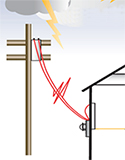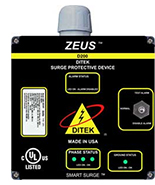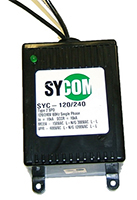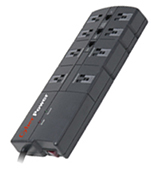 Let's face it, even surge suppressor salesmen have trouble understanding which surge suppressor to recommend and why. Surge suppressor manufactures, and UL for that matter, add to the confusion by changing the standards and recommendations every couple of years. Some of this is because of field testing and observation, but some of it is just myth, or over caution, and even among experts, debate continues. This article will present some of the most frequently asked questions and offer explanations in a less technical fashion in order to remove some of the "smoke and mirrors" of surge suppression. Let's face it, even surge suppressor salesmen have trouble understanding which surge suppressor to recommend and why. Surge suppressor manufactures, and UL for that matter, add to the confusion by changing the standards and recommendations every couple of years. Some of this is because of field testing and observation, but some of it is just myth, or over caution, and even among experts, debate continues. This article will present some of the most frequently asked questions and offer explanations in a less technical fashion in order to remove some of the "smoke and mirrors" of surge suppression.
Why are there so many choices for overcurrent protection?
In an effort to avoid degradation due to surges, many SPD manufacturers design SPD's with high surge current capabilities either by using physically larger components or by connecting multiple components in parallel. This is done to avoid the likelihood that the ratings of the SPD as an assembly are exceeded except in very rare and exceptional instances. Essentially, the heavier gauge units with more robust components last longer because they can handle more surge repetitions. This is why a surge arrestor is more heavy duty than a TVSS - the location (between power lines and the building) is more susceptible to bigger surges. The key thing to remember is that the more prone your environment is to surge, the larger the overcurrent rating should be. A suppressor at the service panel must be able to handle higher surge currents than one on a branch panel.
How much surge current per phase do I need for a 200A panel or a 400A panel?
 This question is related to the "why so many choices" question. Surge current per phase (kA/phase) has become the standard parameter for comparing suppression devices. Most reputable manufacturers publish surge current ratings on a per-mode and per-phase basis. Every year, it seems that manufacturers make bigger and bigger surge current units - some as high as 1000 kA/phase! Here are some interesting facts from the IEEE: This question is related to the "why so many choices" question. Surge current per phase (kA/phase) has become the standard parameter for comparing suppression devices. Most reputable manufacturers publish surge current ratings on a per-mode and per-phase basis. Every year, it seems that manufacturers make bigger and bigger surge current units - some as high as 1000 kA/phase! Here are some interesting facts from the IEEE:
- 50% of recorded direct lightning strokes are less than 18,000A
- 0.02% of the strokes could have a surge current of 220 kA
- An unusual event was recorded that had a stroke of approximately 450 kA; however, this is a controversial measurement
In Florida (worst case in the U.S.), there are six ground flashes/year/km2 (IEEE C62.41). A facility occupying one acre will experience one direct strike every 40 years. Based on the percentages in Figure 9, the facility will experience one stroke exceeding 200 kA every 800 years. So, why have a unit that is 200 kA/phase? The answer is: life expectancy. Bigger units are more durable. It doesn't matter how many amps your main panel carries; it matters how much exposure your environment has to surges. The unit is more likely to fail because of temporary overvoltage than nearby lightning because of their design. Raising the max operating voltage of these units would inevitably reduce their TOV sensitivity.
Do I need Surge Arrestor or TVSS
A Surge Arrestor, currently known as a Type 1 SPD (surge protection device) is the first layer of protection. They are generally intended to be installed before the meter on the power line side of the main service disconnect. They are larger and use heavier gauge wire and components to divert the surge before it enters the building. Because these units are installed outside the main panel, they will NOT protect against transient surges that originate INSIDE the building like from elevators or compressors. TVSS units are called Type 2 SPD's, and are installed after the main service panel to a breaker (the load side), and they protect equipment that is connected to the main panel. Note: The location of the connection is the main difference - a Type 1 surge arrestor connected to the load side works just like a Type 2 (like using a sword instead of a knife to cut steak).
Surge, Transient Voltage, TOV?
 A transient and a surge are the same anomaly - a usually short burst of voltage and/or current in a circuit. These are characterized by a rapid rise in current with a slower fall. On the other hand, temporary over voltages (TOV's), are characterized by a longer oscillating voltage surge because they are caused by a line to ground fault, like when you get zapped by an exposed wire, or two phases crossing, like damaged insulation. This is one of the dilemmas of an MOV based unit like a TVSS where the clamping voltage is low. "An extended TOV can cause permanent damage to an SPD and render the unit inoperable. Note that while UL 1449 (4th Edition) ensures that the SPD will not create a safety hazard under these conditions, SPDs are not designed to protect against TOVs."(NEMA) A transient and a surge are the same anomaly - a usually short burst of voltage and/or current in a circuit. These are characterized by a rapid rise in current with a slower fall. On the other hand, temporary over voltages (TOV's), are characterized by a longer oscillating voltage surge because they are caused by a line to ground fault, like when you get zapped by an exposed wire, or two phases crossing, like damaged insulation. This is one of the dilemmas of an MOV based unit like a TVSS where the clamping voltage is low. "An extended TOV can cause permanent damage to an SPD and render the unit inoperable. Note that while UL 1449 (4th Edition) ensures that the SPD will not create a safety hazard under these conditions, SPDs are not designed to protect against TOVs."(NEMA)
What is UL 1449?
UL 1449 is the standard for all equipment installed on the load side of the AC electrical service and throughout the facility for AC distribution systems. This includes both hardwire and plug-in products. To obtain a UL listing, the suppressor must meet the required safety standards and pass a duty cycle test. In addition, UL conducts a let through voltage test on the suppressor and assigns a suppressed voltage rating (SVR). TVSS are designed to prevent high energy, short duration (typically two milliseconds or less) transient voltages from causing damage to an electrical installation. TVSS are not designed to sustain long-term overvoltages.
The 1449 standard also recognizes cord connected TVSS (Type 3 SPD), also called point-of-use, and a new category of component SPD (Type 4 SPD) includes discrete components as well as component assemblies. The last nomenclature modification is the change of SVR (suppressed voltage rating) to VPL (voltage protection level). The new VPL ratings are required to be displayed on the UL tags for the each SPD unit. Type 5 SPD's consist of discreet electronic components like MOV's and are not truly complete SPD's.
How many Joules do I need?
 A surge protector's Joule Rating tells you how much energy the surge protector can absorb before it fails. A higher number indicates "greater protection". The truth is that Joule ratings are not an approved specification for surge protective devices. IEEE, IEC and NEMA do not recommend using Joule ratings when specifying or comparing surge suppressors, because they can provide misleading and conflicting information. For example, on a 120V system, a 150V or 175V MOV (metal oxide varistor) could be used. Even though the 175V MOV has a higher Joule rating, the 150V has a much lower let-through voltage and offers better surge protection. When a surge protector is submitted for third party testing with Underwriters Laboratories (UL), a Joule rating is not even a tested parameter. Remember that plug-in outlets that often are marked with Joule ratings should be considered the 3rd level of protection, after the surge arrestor or TVSS connected to the main panel. A surge protector's Joule Rating tells you how much energy the surge protector can absorb before it fails. A higher number indicates "greater protection". The truth is that Joule ratings are not an approved specification for surge protective devices. IEEE, IEC and NEMA do not recommend using Joule ratings when specifying or comparing surge suppressors, because they can provide misleading and conflicting information. For example, on a 120V system, a 150V or 175V MOV (metal oxide varistor) could be used. Even though the 175V MOV has a higher Joule rating, the 150V has a much lower let-through voltage and offers better surge protection. When a surge protector is submitted for third party testing with Underwriters Laboratories (UL), a Joule rating is not even a tested parameter. Remember that plug-in outlets that often are marked with Joule ratings should be considered the 3rd level of protection, after the surge arrestor or TVSS connected to the main panel.
1. http://www.nemasurge.org/what-is-spd/
2. http://www.eaton.com/ecm/groups/public/@pub/@electrical/documents/content/sa01005003e.pdf
3. https://en.wikipedia.org/wiki/Surge_protector
4. http://www.nemasurge.org/faqs/
|